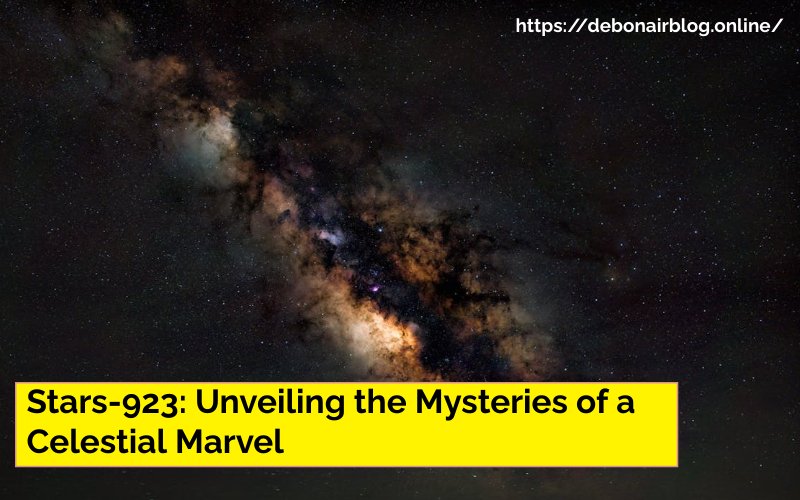
Stars-923: Unveiling the Mysteries of a Celestial Marvel
Table of Contents
Welcome to the captivating exploration of Stars-923, a celestial marvel that has intrigued astronomers and stargazers alike. This star, renowned for its unique characteristics and profound implications for our understanding of the universe, offers a window into the complexities of stellar phenomena.
In this journey, we will delve into the remarkable features of Stars-923, the discoveries that have shaped our knowledge of it, and the broader impact it has on cosmic studies. So, grab your telescope, and let’s embark on this cosmic journey together!
The Allure of Stars-923
Stars-923 is not merely another star among the countless celestial objects scattered across the universe; it is a beacon of intrigue that has captured the imagination of scientists and enthusiasts for decades. Its brilliance and distinct features make it a subject of fascination within the field of astrophysics.
One of the defining aspects of Stars-923 is its extraordinary luminosity, which allows it to be seen from great distances, making it a prominent figure in the night sky.
The star’s allure extends beyond its mere visibility. Its spectral classification reveals a complex mixture of elements, offering a glimpse into the processes of nucleosynthesis that occur within.
This classification is crucial for understanding how different elements are forged in stellar environments and subsequently distributed throughout the cosmos.
Stars-923 serves as a natural laboratory for studying these fundamental processes, providing valuable data that helps astronomers piece together the puzzle of stellar evolution.
The Journey of Discovery
The history of Stars-923 is rich with scientific milestones that have significantly advanced our understanding of stellar evolution. First documented in the early 20th century, the star has been the focal point of numerous astronomical missions and research endeavors.
Each of these missions has contributed to our evolving comprehension of Stars-923, unveiling new facets of its nature and behavior.
In the early stages, observational tools were relatively primitive compared to today’s standards. However, even with the limitations of early technology, astronomers were able to make groundbreaking observations that laid the groundwork for future research.
As technology advanced, so did our ability to study Stars-923 in greater detail.
The advent of advanced telescope imaging technologies has been particularly transformative. Instruments like the Hubble Space Telescope have played a pivotal role in capturing high-resolution images of Stars-923.
These images not only showcase the star’s stunning visual appeal but also provide critical data about its characteristics, such as its light curves and spectral lines. Such data are invaluable for analyzing the star’s behavior and understanding its place in the broader context of stellar science.
Stellar Evolution and Lifecycle

Understanding the lifecycle of Stars-923 is key to grasping the broader processes that govern star formation and evolution. Like all stars, Stars-923 begins its life in a nebula—a vast cloud of gas and dust that serves as the stellar nursery.
Over time, gravitational forces cause the nebula to condense, leading to the formation of a protostar.
As the protostar contracts, temperatures and pressures increase until nuclear fusion ignites in the core. This marks the beginning of the main sequence phase of Stars-923’s lifecycle. During this phase, the star fuses hydrogen into helium, generating the energy that powers it and produces the light we see.
As Stars-923 ages, it undergoes significant changes. Eventually, it will exhaust its hydrogen supply, causing it to expand into a red giant. This phase is characterized by dramatic alterations in the star’s appearance and behavior.
The star’s outer layers will expand, and its core will contract, leading to changes in its luminosity and temperature.
Understanding these evolutionary stages is essential for grasping how stars like Stars-923 contribute to the cosmic cycle of matter.
The transformation of Stars-923 from a main-sequence star to a red giant and eventually to its final stage—whether as a white dwarf, neutron star, or supernova—provides insights into the life cycles of other stars and the formation of stellar remnants.
Unique Characteristics of Stars-923
What sets Stars-923 apart from other stars are its unique characteristics, which provide valuable insights into stellar behavior and dynamics. One of the most notable features is its temperature fluctuations.
These variations in temperature can reveal important information about the star’s internal processes and interactions with its surrounding environment.
Stars-923 also exhibits variability in brightness, a phenomenon known as stellar variability. This variability can be attributed to several factors, including gravitational interactions with nearby celestial objects or potential eclipsing features.
The study of these brightness fluctuations is crucial for understanding the dynamics of star systems and the factors that influence stellar behavior.
Additionally, Stars-923’s spectral classification reveals a diverse array of elements in its atmosphere. By analyzing these spectral lines, astronomers can gain insights into the star’s composition, the processes occurring within it, and the broader implications for our understanding of stellar and galactic phenomena.
The Search for Exoplanets
One of the most exciting aspects of studying Stars-923 is the potential for discovering exoplanets within its system. Exoplanets—planets that orbit stars outside our solar system—have become a major focus of astronomical research.
The possibility of planets orbiting Stars-923 has sparked considerable interest among scientists and the public alike.
The search for exoplanets involves monitoring the star’s light for any periodic changes that may indicate the presence of orbiting planets. By studying these variations, astronomers can infer the presence of exoplanets and analyze their characteristics.
This ongoing research not only enhances our understanding of Stars-923 but also contributes to the broader field of cosmic exploration and the search for life beyond Earth.
Recent studies have suggested that Stars-923 may host one or more exoplanets. These findings are significant because they offer a glimpse into the potential habitability of planets orbiting other stars.
As research continues, we may uncover more details about the exoplanets in the Stars-923 system and their potential for supporting life.
Telescope Imaging: A Window to the Cosmos

The role of telescope imaging in studying Stars-923 cannot be overstated. Advanced telescopes equipped with high-resolution cameras have revolutionized our ability to observe and analyze celestial objects.
These telescopes capture breathtaking visuals that reveal intricate details about the star, providing valuable data for astronomers.
The Hubble Space Telescope, for example, has made significant contributions to our understanding of Stars-923. Its high-resolution images have provided insights into the star’s structure, behavior, and interactions with surrounding objects.
These images have not only enhanced our knowledge of Stars-923 but also inspired awe and curiosity about the cosmos.
Satellites equipped with specialized instruments have also played a crucial role in studying Stars-923. These instruments can detect light signatures that are invisible to the naked eye, unveiling new dimensions of the star’s composition and behavior.
The combination of ground-based and space-based observations has provided a comprehensive view of Stars-923 and its place in the universe.
Recent Discoveries and Insights
Recent studies of Stars-923 have unveiled groundbreaking insights that challenge previous assumptions and enhance our understanding of stellar phenomena. One of the most notable discoveries is the detection of unusual spectral lines in the star’s atmosphere.
These spectral lines indicate the presence of rare elements, which provide new clues about the star’s composition and the processes occurring within it.
Additionally, researchers have observed dynamic temperature fluctuations in Stars-923’s atmosphere. These fluctuations reveal previously unobserved atmospheric conditions, shedding light on the star’s internal dynamics and interactions with its environment.
These discoveries highlight the importance of ongoing research and the need for advanced imaging techniques to uncover the secrets of Stars-923.
The Future of Stars-923 Research
Looking ahead, the future of studying Stars-923 is filled with promise. Ongoing advancements in telescope technology and observational techniques will enable researchers to gather even more data about the star’s composition, behavior, and potential for hosting exoplanets.
Upcoming missions and collaborative efforts among global observatories are set to enhance our understanding of Stars-923 and its role in the broader context of cosmic studies.
As technology continues to advance, we can expect even more detailed observations and discoveries related to Stars-923. Each new finding brings us closer to unraveling the mysteries of this celestial marvel and understanding its significance within the universe.
The collaborative nature of modern astronomy, combined with technological innovations, will undoubtedly lead to exciting breakthroughs in our knowledge of Stars-923.
Conclusion: The Importance of Stars-923
Stars-923 stands as a testament to the wonders of the universe and the ongoing quest for knowledge. Its unique characteristics, rich history, and recent discoveries provide invaluable insights into stellar evolution and cosmic phenomena.
Each new piece of information about Stars-923 adds another layer to our understanding of how stars form, evolve, and ultimately end their lives.
The stunning images captured by advanced telescopes not only inspire awe but also hold the key to unlocking the secrets of our universe. As technology continues to evolve, our ability to study Stars 923 and other celestial objects will only improve, leading to even more extraordinary findings.
Engaging with the wonders of Stars 923 encourages curiosity and deepens our appreciation for the night sky. Exploring this star is more than a scientific endeavor; it invites us to marvel at the beauty and complexity of the cosmos.
FAQs About Stars-923
1. What is Stars-923?
Stars-923 is a celestial star renowned for its extraordinary luminosity and unique characteristics. Its features make it a significant subject of study in astrophysics and stellar research.
2. How was Stars 923 discovered?
Stars 923 was first documented in the early 20th century through initial observational studies. Over time, advancements in technology, including sophisticated telescopes and imaging techniques, have provided deeper insights into the star.
3. What makes Stars 923 unique?
Stars 923 is distinguished by its exceptional luminosity, temperature fluctuations, and spectral classification. These characteristics provide valuable insights into stellar processes and dynamics.
4. What is the lifecycle of Stars 923?
Stars 923 undergoes a lifecycle that includes stages such as protostar formation, main sequence, red giant expansion, and eventual transformation into a white dwarf, neutron star, or supernova.
5. Are there exoplanets in the Stars 923 system?
Recent studies suggest the presence of one or more exoplanets orbiting Stars 923. Ongoing research aims to confirm these findings and explore the potential habitability of these planets.
6. How do temperature fluctuations in Stars 923 affect its study?
Temperature fluctuations in Stars 923 provide insights into the star’s internal processes and interactions with its environment. These variations can reveal important information about the star’s behavior and composition.
7. What role does telescope imaging play in studying Stars 923?
Telescope imaging is crucial for observing and analyzing Stars 923. Advanced telescopes capture high-resolution images and spectral data that enhance our understanding of the star’s structure and dynamics.
8. What recent discoveries have been made about Stars 923?
Recent discoveries include unusual spectral lines indicating the presence of rare elements and dynamic temperature fluctuations in the star’s atmosphere. These findings offer new insights into the star’s composition and behavior.
9. How does Stars 923 contribute to our understanding of stellar evolution?
Stars 923 serves as a natural laboratory for studying stellar processes. Its lifecycle and unique characteristics provide valuable data for understanding the broader mechanisms of star formation and evolution.
10. What is the future of research on Stars 923?
The future of research on Stars 923 is promising, with advancements in technology and observational techniques set to provide even more detailed data. Collaborative efforts among global observatories will continue to enhance our understanding of this celestial marvel.
Suggestions:
Enjoyed what you just read? Explore more fascinating topics like ‘Prince Narula’s Digital PayPal Revolution,’ ‘Key Insights from Meet the Press S76E46,’ ‘10 Stunning Budget-Friendly Upgrades for Your Mobile Home,’ ‘The Rise of Vy6ys in Modern Tech 2024,’ and ‘Unveiling Andre Hakkak’s Net Worth.’ Dive in and discover more!”

